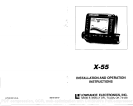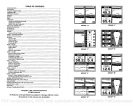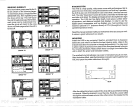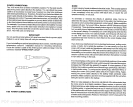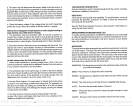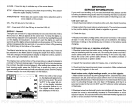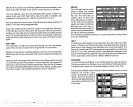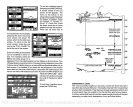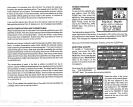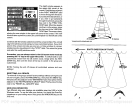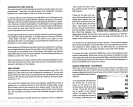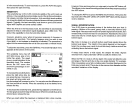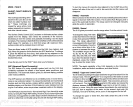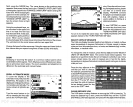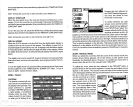
of the
water. For
example,
from 45 to 60 feet.
The smaller the
segment,
the better the
screen resolution will be. The
easiest
way
to do this on the
X-55 is with the
Zoom feature. This feature
expands
the
echoes,
making
it easier to
see detail. For the best
results,
turn the
sensitivity up
as
high
as
possible
without
getting
too much noise on
the screen. In medium to
deep
water,
this method should
work to
display
fish arches.
If
you
see fish
signals
when the
unit is in the manual
mode,
but don't
get
fish
symbols
when the Fish
l.D. feature is
on, try increasing
the
sensitivity.
WATER
TEMPERATURE AND THERMOCLINES
Water
temperature
has an
important-it
not
controlling-influence upon
the
activities
of all fish. Fish are cold blooded
and their bodies are
always
the
temperature
of the
surrounding
water.
During
the
winter,
colder water
slows
down their metabolism. At this
time, they
need about a
fourth as
much food
as
they
consume in the summer.
Mostfish don't
spawn
unlessthe
watertemperature
iswithin rather narrow
limits. A surface
temperature
meter
helps
identify
the desired surface
water
spawning temperatures
for various
species.
Trout can't survive in
streams that
get
too
warm. Bass and other fish
eventually
die out when
stocked in lakes that remain
too cold
during
the summer.
While some
fish
have
awidertemperature
tolerance than
others,
each has a certain
range
within which it tries to
stay.
Schooling
fish
suspended
over
deep
water lie
at the
level that
provides
this
temperature.
We assume
they
are
the most
comfortable
here.
The
temperature
of water in the lake
is seldom constant
from
top
to
bottom.
Layers
of different
temperatures
form,
and the
junction
of a warm
and cool
layer
of water is called a thermocline.
The
depth
and
thickness
of the thermocline
can
vary
with the season
or time of
day.
In
deep
lakes
there
may
be
two or more at different
depths.
Thermoclines are
important
to fishermen because
they
are areas where
fish are active.
Many
times
bait fish will be above
the thermocline
while
larger game
fish will
suspend
in or
just
below
it.
The X-55 can detect this invisible
layer
in the
water,
but the
sensitivity
will
probably
have to be
turned
up
to see it.
VIEWING WINDOWS
OPTIONS
To see all of the available
win-
dow
options, press
the WIN-
DOWS
key,
then
press
the
MENU
key.
Now
press
the
key
adjacentto
the
"MAIN MENU"
label.
Finally,
press
the
key
next to the
"VIEW ALL WIN-
DOWS" label. The
screen at
right appears.
The firstwindow
appears
in the
upper right
corner
of the screen. A
description
of
the screen shows in the
box atthe bottom of the
screen. Now
press
the
key
adjacent
to the "NEXT"
label.
This
changes
the
displayed
window and
description.
When
you've
finished
viewing
the windows,
press
the
CLEAR
key.
MODIFYING
GROUPS
To
modify
or "customize" a
group,
first
press
the WIN-
DOWS
key,
then
press
the
MENU
key.
Now
press
the
key
adjacent
to the
"MAIN MENU"
label at the bottom
of the
screen. The screen shown
be-
low
appears.
PAGE
Select the letter
of the
group
you
wish
to customize
by press-
ing
the
key
adjacent
to the
group's
label. If the
label isn't
shown on
this
page,
press
the
key adjacent
to
the "MORE"
label. In this
example,
the
key
next to the "GROUP
A" label
was
pressed.
The screen
shown
at the
top
of the next
page
appears.
I
FEET
I
58.2
Digital Depth
WATER
DEPTH DISPLAY.
DEPTH ALARMS
AND
UNITS
OF MEASURE
ARE
SET IN MENU.
Mould AND GROUP
V
-IELP
EW At -U 'IDOI,JS
RE—PROGRAM
i-i GROUP
ADJUST
IJ SPLA CONTRAS
Now
press
the
key adjacent
to
the "RE-PROGRAM
A
GROUP" label. The screen shown
below
appears.
'GROUP
AH SELECT 6ROUP
E
GROUP I
él
TO BE
flOUP
F'
CHANGED
TGROUP
CGR0UP
G'
GROUP
DGROUP
30
PRESET
PILL GROUPS'
CLEAR I MORE
7
PDF compression, OCR, web-optimization with CVISION's PdfCompressor



